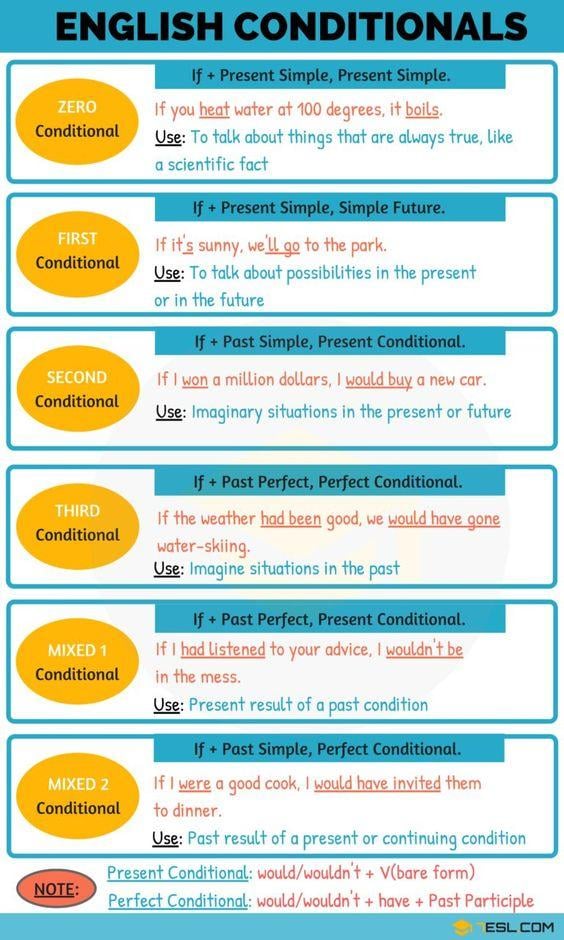Conditionals are sentences which are also known as ‘if clauses.’ These types of sentences are an important concept for anyone learning the language to understand. Let's take a look at the different conditionals in the infographic below.

Conditionals are sentences with two clauses, an “if” clause and a main clause. Generally, conditional sentences are often divided into different types. Let's take a look at each of them.
Zero Conditional
(Present Real Conditional)
In general, “zero conditional” refers to conditional sentences that express a fact, rather than describing a hypothetical situation or potential future circumstance. The grammar term is typically used in the present tense, however such sentences can be formulated with a variety of tenses/moods, as appropriate to the situation.
How to use: We use the zero conditional to talk about things that are always true, like a scientific fact.
For example:
- If you mix yellow and green, you get blue.
- If it rains, the ground gets wet.
- If I go to bed early, I wake up early.
First Conditional
(Present or Future Real Conditional)
“First conditional” refers to a pattern used in predictive conditional sentences, i.e. those that concern consequences of a probable future event. In the basic first conditional pattern, the condition is always expressed using the present tense, while the consequence uses the future construction with “will” (or “shall”).
How to use: We use the first conditional when we talk about possibilities in the present or in the future.
- If we need to, we’ll just rent a car.
- If I find his address, I’ll send his an invitation.
- Liza will buy the drinks if somebody helps her carry the bottles.
Second Conditional
(Present Unreal Conditional)
The “second conditional” refers to a pattern used to describe hypothetical, typically counterfactual situations with a present or future time frame (for past time frames the third conditional is used). In the normal form of the second conditional, the condition clause is in the past tense and the consequence is expressed using the conditional construction with the auxiliary “would”.
How to use: The second conditional is used to talk about Imaginary situations in the present or future.
For example:
- If he had more time, he would visit the south of France.
- She could win the prize if she studied hard.
Third Conditional
(Past Unreal Conditional)
In general, “third conditional” is a pattern used to refer to hypothetical situations in a past time frame, generally counterfactual (or at least presented as counterfactual). Here the condition clause is in the past perfect, and the consequence is expressed using the conditional perfect.
How to use: We use the third conditional when we talk about Imagine situations in the past.
For example:
- If he had practiced more last week, he could have passed the driving test.
- I would have written you a postcard if I had had your address.
Mixed Conditionals
Besides the main conditionals, there are also various "mixed conditionals". This refers to a mixture of the second and third conditionals (the counterfactual patterns). Here either the condition or the consequence, but not both, has a past time reference.
Mixed 1 Conditional
(Present result of a past condition)
When the condition refers to the past, but the consequence to the present, the condition clause is in the past perfect (as with the third conditional), while the main clause is in the conditional mood as in the second conditional (i.e. simple conditional or conditional progressive, but not conditional perfect).
How to use: Present result of a past condition.
For example:
- If she hadn’t gona to bed so late last night, she wouldn’t be so tired today.
- If he had worked harder at school, he would go to university now.
Mixed 2 Conditional
(Past result of a present or continuing condition)
When the consequence refers to the past, but the condition is not expressed as being limited to the past, the condition clause is expressed as in the second conditional (past, but not past perfect), while the main clause is in the conditional perfect as in the third conditional.
How to use: Past result of a present or continuing condition.
For example:
- If I were you, I would have learned Chinese in school.
Are you interested in teaching English as a foreign language? Get your TEFL or TESOL certification with ITTT.
Register now & get certified to teach english abroad!


